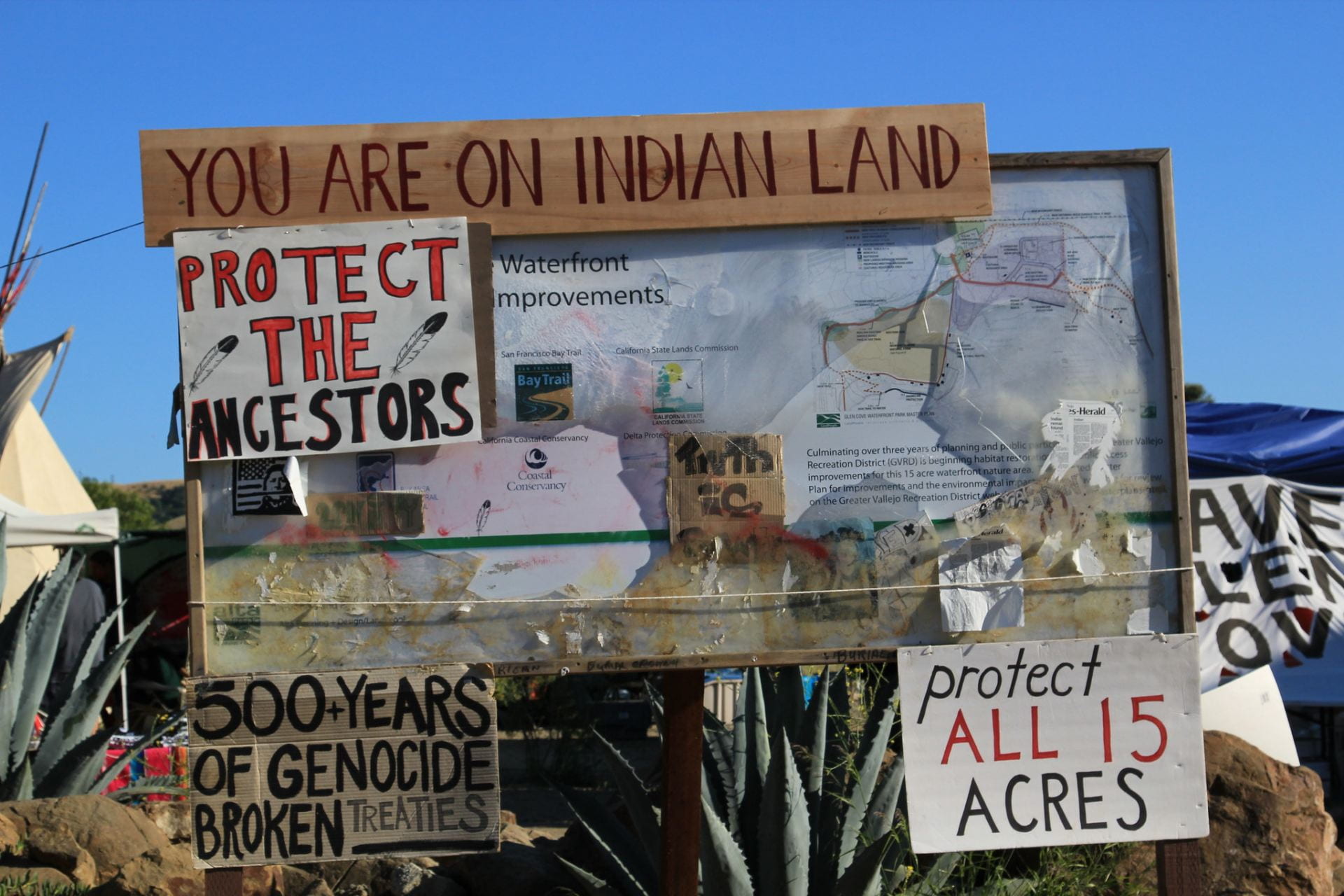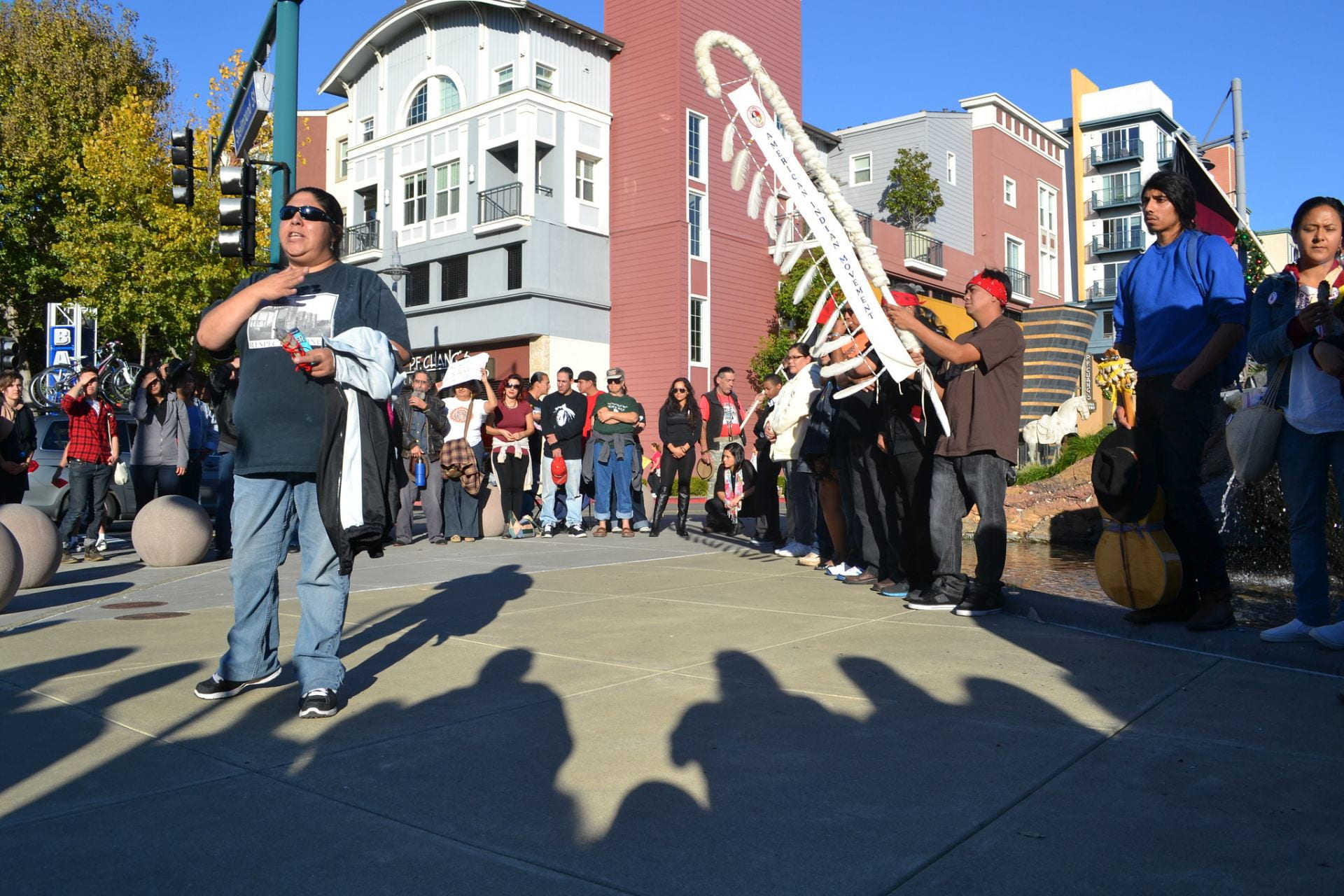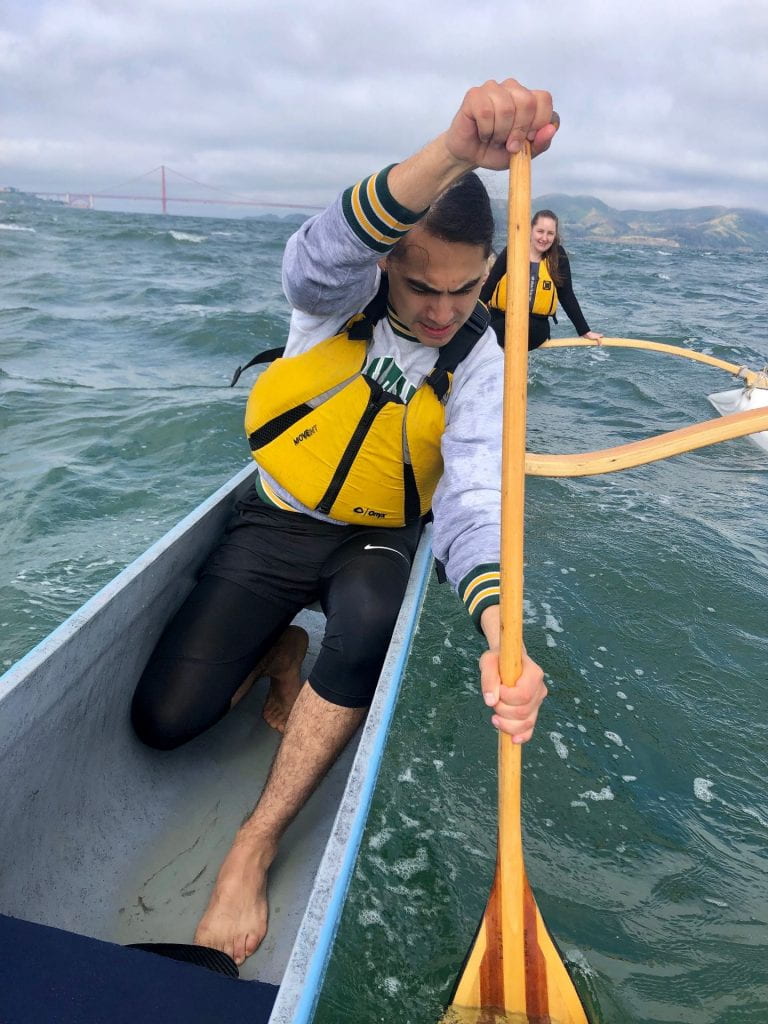Matthew Harrison Tedford
February 2020

Sogorta Te’ Occupation, July 20, 2011. Photo credit: Dignidad Rebelde licensed under CC BY 2.0 (https://creativecommons.org/licenses/by/2.0/)
Last fall, 2019, activists and organizations across the San Francisco Bay Area commemorated the 50th anniversary of the 1969 occupation of Alcatraz Island by Indigenous activists. That historic action began on the morning of November 20, the twilight of that tumultuous decade, when dozens of members of a group called Indians of All Tribes set out for the site of the infamous federal penitentiary that had closed six years earlier. Though the Coast Guard prevented many of the activists and their families from reaching the island, a small contingency made it ashore. Their ranks swelled over time, and the occupation lasted until June 1971. The occupation is now considered a watershed moment in the modern Native American rights movement, and some have likened it to the Montgomery bus boycott of the 1950s.[1]
One of the 2019 commemorations of the occupation was the October 15 Alcatraz Canoe Journey, during which eighteen canoes from tribes and families as far as Canada and Hawaiʻi converged and encircled Alcatraz to “symbolically reclaim” the island “on behalf of Indians of All Tribes,” as Julian Brave NoiseCat, one of the organizers, describes the event.[2] In conjunction with the Canoe Journey, organizers and the Natural History Museum produced Alcatraz: An Unfinished Occupation, a series of talks and panels that discussed the Indigenous Canoe Movement, struggles to assert land claims, environmental activism, and a discussion with occupiers from 1969.[3] The Natural History Museum is a traveling museum that differentiates itself from traditional natural history institutions by its highlighting of “the socio-political forces that shape museums.” In particular, the Natural History Museum focuses on the destructive forces of capitalism and colonialism and increasingly presents Indigenous perspectives on climate justice and environmental activism. In this spirit, the panels associated with An Unfinished Occupation addressed serval recurring themes, principal among them was the importance of cultural continuation and the Indigenous stewardship of land it necessitates.
Landless in the Bay Area was a panel conversation held at the San Francisco Public Library on October 23 that addressed the historical and contemporary conditions that have left several local Indigenous people without land or federal recognition and the significant cultural implications of such a condition. The panel included Corrina Gould (Confederated Villages of Lisjan), Ruth Orta (Ohlone/Bay Miwok/Plains Miwok), and Dr. Jonathan Cordero (Ramaytush Ohlone).
Born in Oakland, California, Gould is a co-founder of Indian People Organizing for Change (IPOC) and the Sogorea Te’ Land Trust. IPOC is a small, grassroots organization which, among other issues, has been dedicated to preserving the West Berkeley Shellmound, an ancient burial site of the ancestors of today’s Ohlone people, above which a retail and housing development has been proposed on the last remaining undeveloped portion of the sacred site. Gould described the shellmound as “a part of our cosmology” and “the first place that our ancestors were buried along the waterways there,” affirming that this is not just a site of historical importance but integral to her people’s identity and being.

Corrina Gould at Annual Bay Street Mall Protest Emeryville, 2012. Photo credit: Wendy Kenin licensed under CC BY-ND 2.0 (https://creativecommons.org/licenses/by-nd/2.0/)
Just days before the talk at the library, an Alameda County Superior Court judge ruled in favor of the City of Berkeley’s denial of the developer’s application for a speedy review process.[4] As Gould acknowledged during the conversation, the ruling does not mean the struggle to protect the shellmound is over—”They’re going to want to appeal it,” she said of the developers—but still, she said it is cause for celebration. “We need to celebrate our wins,” she explained, “because in a time of so many crises in the world right now, we have so few of them. The West Berkeley Shellmound gives us hope. It gives us something to wrap our minds around, that we can get behind and that we can protect, and that we can know.”
The Sogorea Te’ Land Trust, which describes itself as an “urban Indigenous women-led land trust,” was founded with similar aims as the West Berkeley Shelllmound fight: to preserve access to return Chochenyo and Karkin Ohlone lands to Indigenous stewardship. The trust’s name comes from Sogorea Te’ (also known as Glen Cove), a sacred burial and ceremonial ground located in the North Bay city of Vallejo. Since 1988, local authorities have pursued a plan of turning this site into a public park with a parking lot, restrooms, trails, and picnic tables. Indigenous communities from across the region have resisted this plan as a desecration and a violation of human rights.[5] In 2011, in the tradition of the Alcatraz Occupation, a group of activists began what would become a four-and-a-half month long occupation of Sogorea Te’. By the end of the occupation, the activists had secured California’s first-ever cultural easement and a settlement agreement between local authorities and the Yocha Dehe Wintun Nation and the Cortina Band of Wintun Indians.[6] Among other stipulations, the agreement states that the site “will be retained in perpetuity in its natural, cultural, scenic, recreational, historic, and open space condition,” that tribal authorities can access the site to “exercise cultural and traditional practices and life ways,” that the tribal authorities have the right to return the site “to its native condition through the planting and cultivation of native species, and that the Greater Vallejo Recreation District must work with them to “preserve the privacy, sanctity, and integrity” of burial sites.[7] Under the agreement, the restroom facilities were canceled and the parking lot was downsized and relocated to a location that was tested to confirm that it does not contain human remains or cultural artifacts.[8]
This occupation was only barely noticed by the media at the time, and it is not without limits. But it was nonetheless a great success. Reflecting on the occupation several months later, Gould wrote of what was accomplished: “Human beings need to be needed, and for some, this sacred place gave us a place to belong, a place that we each had worth, and a place where prayers are answered.”[9] Part of this success, however, as Gould explained at Landless in the Bay Area, hinged upon the two federally recognized tribes stepping in to work with the city. Though Sogorea Te’ is located on Karkin Ohlone territory, its members lack federal recognition, which meant the community couldn’t be a party to the cultural easement.
Later Gould learning about Indigenous land trusts as a potential tool, but also that most land trusts are “boys’ clubs.” She and IPOC co-founder Johnella LaRose began looking at the history of men holding land. They began to realize that, Gould explained, “there’s a correlation to what happens to women’s bodies and what happens to the land. The raping of resources is the same as the raping of the body. … . This is an ongoing process.” This education, and the success of the Sogorea Te’ occupation, led Gould and LaRose to create a trust dedicated to women-led re-matriation of land. The Shuumi Land Tax is a key of the Sogorea Te’ Land Trust’s work, described by the trust as “a voluntary annual financial contribution [made by] non-Indigenous people living on traditional Chochenyo and Karkin Ohlone territory.” A residential renter paying less than $1,500 a month is asked to contribute $67.50 per year, while owners of 4+ bedroom homes are asked to contribute $500 per year. The fund supports the acquisition and preservation of Ohlone land and the establishment of other community sites.
It’s worth noting that during the panel Gould never spoke about ownership, and the word only appears on the trust’s website in relationship to the land tax property owners are asked to pay. It’s not that the trust eschews ownership as a strategy, but unlike, say, the “American Dream,” ownership isn’t a value of the trust in its own right. “Sogorea Te’ Land Trust,” Gould explains, “is about re-connecting human beings back to the land, and creating our spiritual places and centers again.” In fact, Ruth Orta, an Ohlone elder, assailed the very idea of land ownership as a value, not just of colonial ownership, but private property as a whole. “As far as I’m concerned about the land, we didn’t own the land,” she says of her ancestors before colonialism. Instead of a model of private property, Orta says that Indigenous people “lived here on the land and took care of it.” No Indigenous people, she argued, would have set aside an area and claim, “This is my land.”

Ruth Orta speaking at West Berkeley Shellmound Interfaith Vigil November 6, 2016: Photo credit: Wendy Kenin licensed under CC BY-ND 2.0 (https://creativecommons.org/licenses/by-nd/2.0/)
Dr. Jonathan Cordero, a chairperson of the Association of Ramaytush Ohlone and a sociology professor at California Lutheran University, extended this line of thinking further to encompass the concepts of rights as well, highlighting a key distinction between rights and responsibilities. “Native peoples historically don’t have rights,” he explains, “we don’t own land, we don’t have a right to own land. We never have.” These, then, are foreign concepts with which contemporary Indigenous people have to navigate and use strategically. But Cordero isn’t happy about this, imploring the audience to “think of how crazy it is that we have to ask people’s permission to go onto their property to hold ceremony.” And if property rights and ownership aren’t the ultimate goal of the Sogorea Te’ Land Trust, the shellmound fight, or the various activities of the panelists, Cordero makes the true aim clear:
Sovereignty is essentially defined for Native peoples as cultural continuance. It’s our capacity to continue into the future as a culturally distinct group of people with a shared ancestry. And land, our relationship with the land, our connection with the land, is absolutely, one-hundred percent critical to our capacity to carry ourselves forward as a culturally distinct group of people.
In another of the Unfinished Occupation panels, The Indigenous Environmental Movement, held at the Exploratorium on November 6, several activists connected these ideas about sovereignty and cultural continuance with direct action and environmental activism. Reflecting on recent protest actions, including during the 2018 Global Climate Action Summit in San Francisco, Dr. Melinda Micco (Seminole/Creek/Choctaw), a member of the Idle No More SF Bay, declared that “we don’t need permits; this is our land.” She described her group as modeling Indigenous leadership values. The organization is matriarchal, grandmother-led, and non-hierarchical. Members are committed to non-violent direct action and the idea that “we are all related.” “We have no human enemies,” Micco explained. This sentiment was echoed by fellow Idle No More SF Bay member Isabella Zizi (Northern Cheyenne/Arikara/Muscogee) who explained that “we stand for things we need, not things we’re against.” In these ways, Idle No More is fundamentally affirmative rather than reactionary, even if their protests are reactions to political events. They share this principle of modeling the world they want to see with the Sogorea Te’ occupation and the resulting land trust.
Such a strategy is more than theoretical, as poet and Standing Rock occupier Mark Tilsen (Oglala Lakota) argued. Admitting that he had previously been a cynic, uninspired by much of the early #NoDAPL protests, Tilsen said “something clicked” when he started seeing people show up to Standing Rock to protest the Dakota Access Pipeline that would desecrate Sioux land and threaten the Standing Rock Sioux Nation’s water supply. Soon Tilsen learned that “we were able to transform just by doing.” “We weren’t metaphorically stopping them,” he explained, but they literally delaying the construction of the pipeline. Tilsen might be described as a pragmatist, and even with the setbacks ushered in by the election of Donald Trump, he sees the Standing Rodck occupation as having accomplished something real: delay, mobilization, and self-transformation. “Direct action gets the goods,” he concludes, imploring the audience they can delay projects by months by just showing up to government meetings.
From Sogorea Te’ to Standing Rock, these activists highlight that the spirit of the 1969 Alcatraz Occupation is strong and infectious. The panelists made clear the interconnectedness and power of land, culture, and direct action. Despite historic and ongoing injustices, all of the panelists expressed hope. This may be because the panelists know that while the stakes are so high, they’ve all seen the transformative power of their collective action.

Alcatraz Occupation veteran Eloy Martinez holds the talking stick, 2020. Photo credit: Ed Archie NoiseCat
*
[1] Julian Brave NoiseCat, “The Occupation of Alcatraz,” Open Space, November 25, 2019, https://ndncollective.org/alcatraz-canoe-journey-honoring-50-years-of-indigenous-resistance-and-persistence/
[2] Julian Brave NoiseCat, “Alcatraz Is an Idea,” Open Space, December 02, 2019, https://openspace.sfmoma.org/2019/12/alcatraz-is-an-idea-2/
[3] Open Space, an online publication of the San Francisco Museum of Modern Art, published a special issue, Alcatraz Is Not an Island, in conjunction with Alcatraz: An Unfinished Occupation. This issue includes transcripts from the of the panel discussions, new writing, and visual art. https://openspace.sfmoma.org/issue/alcatraz-is-not-an-island/
[4] Emilie Reguso, “Judge rules for Berkeley in developer’s lawsuit over Spenger’s parking lot,” Berkeleyside, October 22, 2019, https://www.berkeleyside.com/2019/10/22/judge-rules-for-berkeley-in-developers-lawsuit-over-spengers-parking-lot
[5] “About Sogorea Te,” Protest Sogorea Te, accessed January 6, 2019, http://protectsogoreate.org/about/
[6] “Yocha Dehe and Cortina Take Lead to Protect Sensitive Sites at Glen Cove,” Yocha Dehe Wintun Nation, August 31, 2011, https://www.yochadehe.org/news/yocha-dehe-and-cortina-take-lead-protect-sensitive-sites-glen-cove
[7] City of Vallejo, “Glen Cove Conservation and Cultural Easement and Agreement,” July 21, 2011, http://www.ci.vallejo.ca.us/common/pages/DisplayFile.aspx?itemId=34082
[8] “Press Release: A Victory for Protection of Sogorea Te,” Protect Sogorea Te, July 20, 2011, http://protectsogoreate.org/2011/easement-press-release/
[9] Corrina Gould, “An update for supporters and friends of Sogorea Te,” Protect Sogorea Te, January 7, 2012, http://protectsogoreate.org/2012/update-letter/#more-4057
